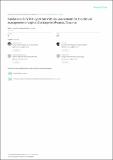| dc.contributor.author | Mayaud, Philippe | |
| dc.contributor.author | ka-Gina, Gina | |
| dc.contributor.author | Cornelissen, Jan | |
| dc.contributor.author | Todd, James | |
| dc.contributor.author | Kaatano, Godfrey | |
| dc.contributor.author | West, Beryl | |
| dc.contributor.author | Uledi, Elizabeth | |
| dc.contributor.author | Rwakatare, Medard | |
| dc.contributor.author | Kopwe, Lilian | |
| dc.contributor.author | Manoko, Domitilia | |
| dc.contributor.author | Laga, Marie | |
| dc.contributor.author | Grosskurthy, Heiner | |
| dc.contributor.author | Hayes, Richard | |
| dc.contributor.author | Mabe, David | |
| dc.date.accessioned | 2021-09-03T14:23:58Z | |
| dc.date.available | 2021-09-03T14:23:58Z | |
| dc.date.issued | 1998-07 | |
| dc.identifier.citation | Mayaud, P., ka-Gina, G., Cornelissen, J., Todd, J., Kaatano, G., West, B., Uledi, E., Rwakatare, M., Kopwe, L., Manoko, D., Laga, M., Grosskurth, H., Hayes, R., & Mabey, D. (1998). Validation of a WHO algorithm with risk assessment for the clinical management of vaginal discharge in Mwanza, Tanzania. Sexually transmitted infections, 74 Suppl 1, S77-84 . | en_US |
| dc.identifier.other | PMID: 10023356 | |
| dc.identifier.uri | http://repository.amref.org/handle/123456789/220 | |
| dc.description.abstract | Objectives: (i) To determine the microbial aetiologies of vaginal discharge in STD clinic and antenatal clinic (ANC) attenders; (ii) to evaluate the performance and costs of a new WHO algorithm for the detection of gonococcal and chlamydial infections in women complaining of vaginal discharge and/or genital itching, using a risk assessment.
Methods: Two groups were enrolled: (i) 395 consecutive female patients attending a hospital outpatient clinic complaining of genital discharge or itching; and (ii) 628 consecutive pregnant women reporting at an urban ANC these symptoms. Patients were interviewed by a nurse, who applied the WHO risk score. They were then referred to the study room for interview concerning the same and other risk factors, examined, and sampled for Neisseria gonorrhoeae (NG), Chlamydia trachomatis (CT), Trichomonas vaginalis (TV), and Candida albicans (CA). Sensitivity, specificity, positive predictive value, overtreatment and correct treatment rates, and cost of drugs per true case treated were estimated.
Results: The prevalence of NG and/or CT infections was 11.4% and 8% at the STD clinic and the ANC respectively. The most prevalent pathogens were CA (38% at both clinics) and TV (25% at the STD clinic and 34% at the ANC). The sensitivity of the WHO algorithm for NG and/or CT was 62% at the STD clinic and 46% at the ANC, and the specificities were 64% and 84% respectively. The operational feasibility of the method was good. The cost of drugs per true case treated in applying the risk assessment approach was $3.5 among nonpregnant women and $5.0 among pregnant women. This compared favourably with respective costs of $8.8 and $25.0 in applying the syndromic management alone.
Conclusions: The WHO risk assessment algorithm for the diagnosis of NG and/or CT infections among women complaining of genital discharge can considerably reduce overtreatment of NG and/or CT in both pregnant and non-pregnant women, but in this study it failed to identify 38% of non-pregnant and 54% of pregnant women with these infections. The elements of the risk score may need adjustment in different settings. | en_US |
| dc.description.sponsorship | STD Department of the Global Department on AIDS (WHO/GPA), Geneva, Switzerland., Commission of the European Communities (DG VIII and DGXII), The formerOverseas Development Administration (ODA), UK, and the Centre for International Migration (CIM) Germany | en_US |
| dc.language.iso | en | en_US |
| dc.publisher | Sexually Transmitted Infections | en_US |
| dc.subject | Vaginal discharge | en_US |
| dc.subject | Gonorrhoea | en_US |
| dc.subject | Chlamydial infection | en_US |
| dc.subject | STD algorithms | en_US |
| dc.subject | Risk assessment | en_US |
| dc.subject | Tanzania | en_US |
| dc.title | Validation of a WHO Algorithm with Risk Assessment for the Clinical Management of Vaginal Discharge in Mwanza, Tanzania | en_US |
| dc.type | Article, Journal | en_US |

